
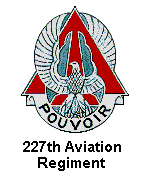
227th Aviation Regiment
Organizational Legacy
"POWER"; or "CAN DO"


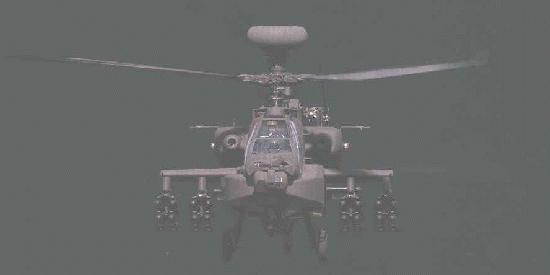 |
|---|
| AH-64D Longbow Reigns Over The Darkness Of The Battlefield. |
|---|

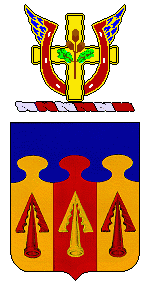
Regimental Coat Of Arms
 Introduction
Introduction


 The 1st Cavalry Division, a major subordinate command of the US Third Mobile
Armored Corps, is a 19,000 soldier, heavy armored division stationed at Ft.
Hood, TX. As one of the two "on-call" heavy contingency force divisions of the
Army, the First Team has an on-order mission to deploy by sea, air or land to
any part of the world on a short notice. The following narratives, divided in
timeline eras of major operational missions, describes the threat environment,
tactical conditions, evolution of equipment technology and the strategic
methodology employed by one of its subordinate units, the 227th Aviation
Regiment, to contribute to the successful missions and enhancement of the
warring organization of the 1st Cavalry Division.
The 1st Cavalry Division, a major subordinate command of the US Third Mobile
Armored Corps, is a 19,000 soldier, heavy armored division stationed at Ft.
Hood, TX. As one of the two "on-call" heavy contingency force divisions of the
Army, the First Team has an on-order mission to deploy by sea, air or land to
any part of the world on a short notice. The following narratives, divided in
timeline eras of major operational missions, describes the threat environment,
tactical conditions, evolution of equipment technology and the strategic
methodology employed by one of its subordinate units, the 227th Aviation
Regiment, to contribute to the successful missions and enhancement of the
warring organization of the 1st Cavalry Division.
Mission:
 On order, the 227th Aviation Regiment deploys to a designated contingency area
of moperations by land, sea, and/or air. On order, provides Aerial Command,
Control and Communications (C3) support, limited Air Assault, Aeromedical
Evacuation and Air Movement for the division.
On order, the 227th Aviation Regiment deploys to a designated contingency area
of moperations by land, sea, and/or air. On order, provides Aerial Command,
Control and Communications (C3) support, limited Air Assault, Aeromedical
Evacuation and Air Movement for the division.
Organizational Summary:
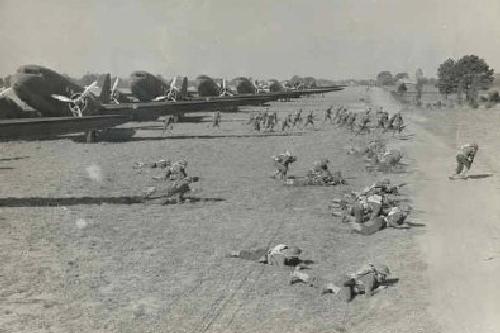 |
|---|
| Practicing Air Assault - 1941 |
|---|
| |
|---|
 It was not one man's dream; the notion of using aircraft or helicopters as the
fast, new steed of modern cavalry. The efforts of many went into the formation
of the first air assault division. More than a decade of flying experiments,
equipment evaluations and development of new hardware and tactics proceeded
the conversion of the 1st Cavalry Division to the Air Assault configuration.
Tests were conducted with troop carrying helicopters and those equipped with
a variety of machine guns and rockets.
It was not one man's dream; the notion of using aircraft or helicopters as the
fast, new steed of modern cavalry. The efforts of many went into the formation
of the first air assault division. More than a decade of flying experiments,
equipment evaluations and development of new hardware and tactics proceeded
the conversion of the 1st Cavalry Division to the Air Assault configuration.
Tests were conducted with troop carrying helicopters and those equipped with
a variety of machine guns and rockets.
 At Ft. Benning, GA., in the mid-fifties, General John R. Tolson developed a
tactical doctrine for the use of helicopters in combat and became one of the
leading, early pioneers in modern airmobility. Several other military
personnel played key roles in development of missions, configurations, and
weapons for air cavalry operations. Lt. General James M. Gavin, Chief of Staff
for Operations of the Department of the Army, campaigned for helicopter units
that could take over, extend and add great speed to the traditional roles of
the cavalry.
At Ft. Benning, GA., in the mid-fifties, General John R. Tolson developed a
tactical doctrine for the use of helicopters in combat and became one of the
leading, early pioneers in modern airmobility. Several other military
personnel played key roles in development of missions, configurations, and
weapons for air cavalry operations. Lt. General James M. Gavin, Chief of Staff
for Operations of the Department of the Army, campaigned for helicopter units
that could take over, extend and add great speed to the traditional roles of
the cavalry.
 Soon thereafter, at the Aviation School at Ft. Rucker, Colonel Jay D.
Vanderpool assembled a "Sky Cavalry" platoon using borrowed personnel and
equipment. The "Sky Cavalry" began giving impressive demonstrations of the
roles that helicopters could play in combat. Heralding the era of gunships,
the "Sky Cavalry" carried and tested a variety of weapons and rockets.
Additional men and other organizations played vital roles in the development
of the "air assault" concept: the Rogers Board, formed on 15 January 1960 and
chaired by Lt. General Gordon B. Rogers; the Howze Board, headed by Lt.
General Hamilton H. Howze, a man with several significant links with the 1st
Cavalry Division; Secretary of Defense Robert S. McNamara and Major General
Harry William Osborne Kinnard.
Soon thereafter, at the Aviation School at Ft. Rucker, Colonel Jay D.
Vanderpool assembled a "Sky Cavalry" platoon using borrowed personnel and
equipment. The "Sky Cavalry" began giving impressive demonstrations of the
roles that helicopters could play in combat. Heralding the era of gunships,
the "Sky Cavalry" carried and tested a variety of weapons and rockets.
Additional men and other organizations played vital roles in the development
of the "air assault" concept: the Rogers Board, formed on 15 January 1960 and
chaired by Lt. General Gordon B. Rogers; the Howze Board, headed by Lt.
General Hamilton H. Howze, a man with several significant links with the 1st
Cavalry Division; Secretary of Defense Robert S. McNamara and Major General
Harry William Osborne Kinnard.
 The main mission of the Rogers Board was to review aircraft requirements of
the Army in three categories: observation; surveillance and transportation.
The findings of the Rogers Board were fine as far as they went, but Robert S.
McNamara believed there was more promise in air mobility than the Rogers
Board revealed. In the spring of 1962, Secretary McNamara ordered a panel of
distinguished military leaders and civilian experts to re-examine the needs of
the Army. This panel became known as the Howze Board and it was granted
sweeping powers to conduct tests, stage war games and study combat in various
areas of the world.
The main mission of the Rogers Board was to review aircraft requirements of
the Army in three categories: observation; surveillance and transportation.
The findings of the Rogers Board were fine as far as they went, but Robert S.
McNamara believed there was more promise in air mobility than the Rogers
Board revealed. In the spring of 1962, Secretary McNamara ordered a panel of
distinguished military leaders and civilian experts to re-examine the needs of
the Army. This panel became known as the Howze Board and it was granted
sweeping powers to conduct tests, stage war games and study combat in various
areas of the world.
 The findings of the Howze Board outlined the requirements for an air assault
division. Such a unit would have five times the number of aircraft of a
regular division along with an extensive reduction in ground vehicles. After
the report was issued, McNamara gave orders to field the air assault concept
and run it through its paces in a tough series of field tests which would
further reveal the strengths and limitations of an air assault force. The unit
chosen for the exercise was the 11th Airborne Division, which was reflagged as
the 11th Air Assault Division. It was commanded by Major General Harry William
Osborne Kinnard.
The findings of the Howze Board outlined the requirements for an air assault
division. Such a unit would have five times the number of aircraft of a
regular division along with an extensive reduction in ground vehicles. After
the report was issued, McNamara gave orders to field the air assault concept
and run it through its paces in a tough series of field tests which would
further reveal the strengths and limitations of an air assault force. The unit
chosen for the exercise was the 11th Airborne Division, which was reflagged as
the 11th Air Assault Division. It was commanded by Major General Harry William
Osborne Kinnard.
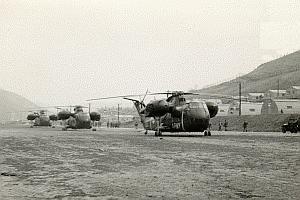 |
|---|
| H-37 Heavy Lift Helicopters |
|---|
| |
|---|
 In 1962 the 1st Cavalry Division was the first division to be totally equipped
with Huey helicopters for artillery observation and "dust off" medical
evacuations. In the spring of 1963, units of the Division began to receive
H-19, H-21 and H-37 helicopters. The Division conducted extensive air assault
familiarization and training. In order to recruit potential helicopter pilots,
personnel records were screened to determine individual results of initial
induction testing. All troopers who had scored well were asked to volunteer
for helicopter training. After passing a flight physical, all who volunteered
(regardless of time remaining on their tour of duty) were transferred to Ft.
Rucker, AL for pilot training.
On 01 February 1963, the Army began to gather helicopters units into the 11th
Air Assault Division to test the airmobile concept. The 31st Transportation
Company was re-designated as the 227th Assault Helicopter Battalion. Elements
of the 227th Aviation were formed and designated as follows:
In 1962 the 1st Cavalry Division was the first division to be totally equipped
with Huey helicopters for artillery observation and "dust off" medical
evacuations. In the spring of 1963, units of the Division began to receive
H-19, H-21 and H-37 helicopters. The Division conducted extensive air assault
familiarization and training. In order to recruit potential helicopter pilots,
personnel records were screened to determine individual results of initial
induction testing. All troopers who had scored well were asked to volunteer
for helicopter training. After passing a flight physical, all who volunteered
(regardless of time remaining on their tour of duty) were transferred to Ft.
Rucker, AL for pilot training.
On 01 February 1963, the Army began to gather helicopters units into the 11th
Air Assault Division to test the airmobile concept. The 31st Transportation
Company was re-designated as the 227th Assault Helicopter Battalion. Elements
of the 227th Aviation were formed and designated as follows:
- "HHC" 227th Aviation Battalion
- "A" Co, 227th Aviation Battalion
- "B" Co, 227th Aviation Battalion; constituted using equipment
and personnel of the Aviation Co, 6th Special Forces Group
- "C" Co, 227th Aviation Battalion; constituted using equipment
and personnel of the Aviation Co, 7th Special Forces Group
- "D" Co, 227th Aviation Battalion; constituted using equipment
and personnel of the 110 Aviation Co, (Aerial Weapons)
 In June 1965, the 2nd Infantry Division joined forces with the 11th Air
Assault Division to form a combined training command. Shortly afterward on 01
July 1965, the 11th Air Assault Division was reflagged with the colors of the
1st Cavalry Division, who had just returned from Korea. Concurrently the 227th
Battalion was relieved from the 11th Air Assault Division (Test) and assigned
to the 1st Cavalry Division (Airmobile). Immediately the 227th Aviation
Battalion, along with the 1st Cavalry Division, was ordered to deploy to
Vietnam as an Air Mobile Division.
In June 1965, the 2nd Infantry Division joined forces with the 11th Air
Assault Division to form a combined training command. Shortly afterward on 01
July 1965, the 11th Air Assault Division was reflagged with the colors of the
1st Cavalry Division, who had just returned from Korea. Concurrently the 227th
Battalion was relieved from the 11th Air Assault Division (Test) and assigned
to the 1st Cavalry Division (Airmobile). Immediately the 227th Aviation
Battalion, along with the 1st Cavalry Division, was ordered to deploy to
Vietnam as an Air Mobile Division.
 Upon their return from Vietnam, the 227th Aviation Battalion was inactivated
on 19 November 1974 at Ft. Hood, Texas. After a brief reactivation from 21
May 1978 until 30 September 1983, it was re-designated as 1st Battalion,
227th Aviation Regiment, the first divisional Apache Attack Helicopter
Battalion to be formed. Upon re-designation, the 227th underwent an intensive
training program and began to training for combat operations.
Upon their return from Vietnam, the 227th Aviation Battalion was inactivated
on 19 November 1974 at Ft. Hood, Texas. After a brief reactivation from 21
May 1978 until 30 September 1983, it was re-designated as 1st Battalion,
227th Aviation Regiment, the first divisional Apache Attack Helicopter
Battalion to be formed. Upon re-designation, the 227th underwent an intensive
training program and began to training for combat operations.
 On 29 September 1990, the Battalion deployed overseas to Dhahran, Saudi
Arabia, where the unit postured for combat in Operation Desert Shield. On 25
February 1991 with the onset of Operation Desert Storm, the Battalion
conducted a raid as a part of the deception plan of the 1st Cavalry Division
to throw Iraqi forces off guard. The Battalion would serve as the vanguard of
the Division's movement north to cut off retreating an Iraqi Republican Guard
Division at Basra. On 07 March 1991, the Battalion returned as part of the
advance party back to Ft. Hood.
On 29 September 1990, the Battalion deployed overseas to Dhahran, Saudi
Arabia, where the unit postured for combat in Operation Desert Shield. On 25
February 1991 with the onset of Operation Desert Storm, the Battalion
conducted a raid as a part of the deception plan of the 1st Cavalry Division
to throw Iraqi forces off guard. The Battalion would serve as the vanguard of
the Division's movement north to cut off retreating an Iraqi Republican Guard
Division at Basra. On 07 March 1991, the Battalion returned as part of the
advance party back to Ft. Hood.
 On 02 June 1998, after years of testing and preparation, the 227th Aviation
Regiment began to field the most advanced attack helicopter ever built, the
AH-64D "Longbow". Just as the English longbow archers provided a great
advantage during medieval battles, the AH-46D Apache Longbow provides the US
Army an overwhelming advantage on the digital battlefields of the 21st
Century.
On 02 June 1998, after years of testing and preparation, the 227th Aviation
Regiment began to field the most advanced attack helicopter ever built, the
AH-64D "Longbow". Just as the English longbow archers provided a great
advantage during medieval battles, the AH-46D Apache Longbow provides the US
Army an overwhelming advantage on the digital battlefields of the 21st
Century.
 The current capability of the 227th Aviation Regiment has been developed in
conjunction with the long history and needs of the 1st Cavalry Division. It is
the combination of the experienced training received by each dedicated member
of the Team and adherence to the performance level and traditions of the past.
As of today, the 227th Aviation Regiment is currently represented by the
following active units:
The current capability of the 227th Aviation Regiment has been developed in
conjunction with the long history and needs of the 1st Cavalry Division. It is
the combination of the experienced training received by each dedicated member
of the Team and adherence to the performance level and traditions of the past.
As of today, the 227th Aviation Regiment is currently represented by the
following active units:
- The 1st Battalion, organized as an Attack Battalion,
is assigned to the 1st Air Cavalry Combat Team of the 1st Cavalry
Division, stationed at Ft. Hood, Texas.
- The 2nd Battalion, organized as an General Support Battalion,
is assigned to the 1st Air Cavalry Combat Team of the 1st Cavalry
Division, stationed at Ft. Hood, Texas.
- The 3rd Battalion, organized as an Assault Battalion,
is assigned to the 1st Air Cavalry Combat Team of the 1st Cavalry
Division, stationed at Ft. Hood, Texas.
- The 4th Battalion, organized as an Attack Battalion,
is assigned to the 1st Air Cavalry Combat Team of the 1st Cavalry
Division, stationed at Ft. Hood, Texas.

 This folio of material highlights of the many subsequent historical critical
missions performed by members of the 227th Aviation Regiment, whose actions,
operations and the many critical issues resolved over its 46 year history to
meet the changing threat and the honors they achieved are summarized in the
following sections:
This folio of material highlights of the many subsequent historical critical
missions performed by members of the 227th Aviation Regiment, whose actions,
operations and the many critical issues resolved over its 46 year history to
meet the changing threat and the honors they achieved are summarized in the
following sections:
 Table of Contents
Table of Contents


























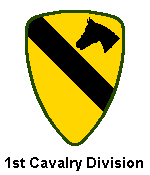



 If none of the data that you have found by surfing the reference unit chapter
titles and indexes measures up to your interests, you may want to deploy the
R&S (Reconnaissance and Surveillance) Scouts to search and identify keywords
or subjects within individual unit pages. Enter the descriptive keyword or
search terms(s) in the input field and "Click" on the Search button to screen the multiple DataBases of
the Cavalry OutPost and the garrisoned occupants - "The 1st Cavalry Division
and its Subordinate Units".
If none of the data that you have found by surfing the reference unit chapter
titles and indexes measures up to your interests, you may want to deploy the
R&S (Reconnaissance and Surveillance) Scouts to search and identify keywords
or subjects within individual unit pages. Enter the descriptive keyword or
search terms(s) in the input field and "Click" on the Search button to screen the multiple DataBases of
the Cavalry OutPost and the garrisoned occupants - "The 1st Cavalry Division
and its Subordinate Units".
 The search action will open the "first-team.us WebSite - R&S Scout Report",
which displays a listing of WebSite Titles and HTML Summaries that contain the
specific search term(s) of interest. To review any that best depicts a match
of your search term(s), "Click" on the WebSite Title to open a New Window.
After the WebSite is fully loaded, use the browser [EDIT/Find] Tool Button to
locate the search term within the page. After reviewing, close the New Window
to return to the listing of WebSites.
The search action will open the "first-team.us WebSite - R&S Scout Report",
which displays a listing of WebSite Titles and HTML Summaries that contain the
specific search term(s) of interest. To review any that best depicts a match
of your search term(s), "Click" on the WebSite Title to open a New Window.
After the WebSite is fully loaded, use the browser [EDIT/Find] Tool Button to
locate the search term within the page. After reviewing, close the New Window
to return to the listing of WebSites.
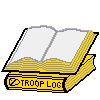



 If this is your first review of the Outpost of the 1st Cavalry Division and
its Subordinate Units, you may want to record your own report on your findings
during your visit, or perhaps you may want to review the log entries of other
visitors.
If this is your first review of the Outpost of the 1st Cavalry Division and
its Subordinate Units, you may want to record your own report on your findings
during your visit, or perhaps you may want to review the log entries of other
visitors.

To report on your findings,
"click" on the "Report-In"
Index Tab of the Troop Log. |
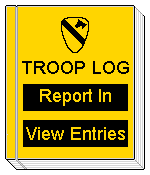
|

To review entries of others,
"Click"on the "View Entries"
Index Tab of the Troop Log. |
|---|

 As you journey through the history of the 1st Cavalry Division and its
assigned elements, you may find it interesting enough to send a message to
your friends and extend them an invitation for the opportunity to review the
rich history of the Division. We have made it easy for you to do. All that is
required is for you to click on the Push Button below, fill in their eMail
addresses and send.
As you journey through the history of the 1st Cavalry Division and its
assigned elements, you may find it interesting enough to send a message to
your friends and extend them an invitation for the opportunity to review the
rich history of the Division. We have made it easy for you to do. All that is
required is for you to click on the Push Button below, fill in their eMail
addresses and send.


|
The TITLE and URL of this WebSite are automatically read, formatted
and entered into your standard eMail form. |
|
|
Note - The eMail Message is processed and transmitted On-Line to the
addressee(s) via your Internet Provider.
Copyright © 2002, Cavalry Outpost Publications ® |




 eMail Your WebSite Comments.
eMail Your WebSite Comments.


 Return to "MyOwnPages"©.
Return to "MyOwnPages"©.

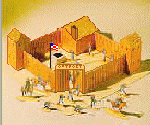 Copyright © 1996, Cavalry Outpost Publications ® and
Trooper Wm. H. Boudreau, "F" Troop, 8th Cavalry Regiment (1946 - 1947). All
rights to this body of work are reserved and are not in the public domain, or
as noted in the bibliography. Reproduction, or transfer by electronic means,
of the History of the 1st Cavalry Division, the subordinate units or any
internal element, is not permitted without prior authorization. Readers are
encouraged to link to any of the pages of this Web site, provided that proper
acknowledgment attributing to the source of the data is made. The information
or content of the material contained herein is subject to change without
notice.
Copyright © 1996, Cavalry Outpost Publications ® and
Trooper Wm. H. Boudreau, "F" Troop, 8th Cavalry Regiment (1946 - 1947). All
rights to this body of work are reserved and are not in the public domain, or
as noted in the bibliography. Reproduction, or transfer by electronic means,
of the History of the 1st Cavalry Division, the subordinate units or any
internal element, is not permitted without prior authorization. Readers are
encouraged to link to any of the pages of this Web site, provided that proper
acknowledgment attributing to the source of the data is made. The information
or content of the material contained herein is subject to change without
notice.
Revised 01 Jan '12 SpellChecked






 Introduction
Introduction

















 Copyright © 1996, Cavalry Outpost Publications ® and
Trooper Wm. H. Boudreau, "F" Troop, 8th Cavalry Regiment (1946 - 1947). All
rights to this body of work are reserved and are not in the public domain, or
as noted in the bibliography. Reproduction, or transfer by electronic means,
of the History of the 1st Cavalry Division, the subordinate units or any
internal element, is not permitted without prior authorization. Readers are
encouraged to link to any of the pages of this Web site, provided that proper
acknowledgment attributing to the source of the data is made. The information
or content of the material contained herein is subject to change without
notice.
Copyright © 1996, Cavalry Outpost Publications ® and
Trooper Wm. H. Boudreau, "F" Troop, 8th Cavalry Regiment (1946 - 1947). All
rights to this body of work are reserved and are not in the public domain, or
as noted in the bibliography. Reproduction, or transfer by electronic means,
of the History of the 1st Cavalry Division, the subordinate units or any
internal element, is not permitted without prior authorization. Readers are
encouraged to link to any of the pages of this Web site, provided that proper
acknowledgment attributing to the source of the data is made. The information
or content of the material contained herein is subject to change without
notice.